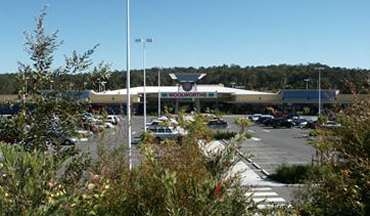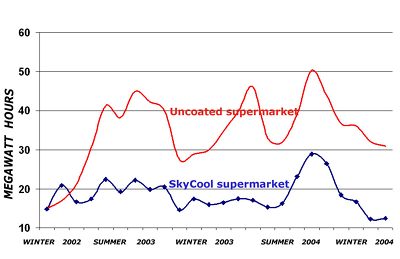 top.jpg)

© SkyCool Pty Ltd 1998 - 2015 - Patented in Australia, U.S.A. & other countries
Phone: +61 2 9477 4095 Email: info@skycool.com.au


With every investment it is important to know with confidence when and what results can be reasonably expected.
In 2002, after carefully examining university analysis and available data, Woolworths, a major national supermarket chain in Australia decided to conduct its own fully fledged field trial. It contracted an independent electrical engineering firm to set up energy meters dedicated to the air conditioning plants of two nearby supermarkets in South East Queensland.
One of the 3,300 square metre supermarkets received an application of SkyCool to its roof, while the other remained as the benchmark. Both buildings had been built and fitted out to a standard design criteria so they were the ideal environment for obtaining a truly accurate picture of the effect of SkyCool.
The engineering firm took monthly readings of the air conditioning energy consumption. Recording continued for more than two years.
The following chart covers periods of both drought and very wet tropical summers. Throughout the entire period it is evident that SkyCool maintained a power consumption level around 47% lower than the standard building.
In analysing this very powerful result it is important to be aware of a number of aspects surrounding this trial:


-
These buildings contain open refrigerators which continually spill very cold air into the general shopping area. This will lower the overall need for air conditioning before SkyCool is employed. Thus in most other building types it is very reasonable to expect an even greater effect in the savings provided by SkyCool.
-
This exacting trial provides more direct proof of SkyCool than measuring temperature or power differences in a before/after scenario because this type of trial responds to near identical weather and involves very stable (i.e. unchanging) buildings, particularly with respect to power usage.
-
Cost of power in this region is one of the lowest in Australia, particularly for a very large national consumer, nevertheless, their SkyCool investment returned a pay back in less than three years - every year thereafter is a bonus to their bottom line
-
Both buildings had a standard 75mm (3 inch) sub-roof insulation which would inhibit the passage of internal heat outwards to the SkyCool coating, thereby limiting SkyCool's maximum effectiveness.
-
The buildings also had a sealed ceiling cavity which further inhibited the outward removal of heat.
-
The air conditioning meters recorded the ventilation power as well as that needed to chill the hot air. Ventilation cannot be reduced as a minimum level is required for reasons of public health. It is estimated that during the winter periods of the trial the SkyCool building would only be operating the ventilation fans without the need for any air chilling.

